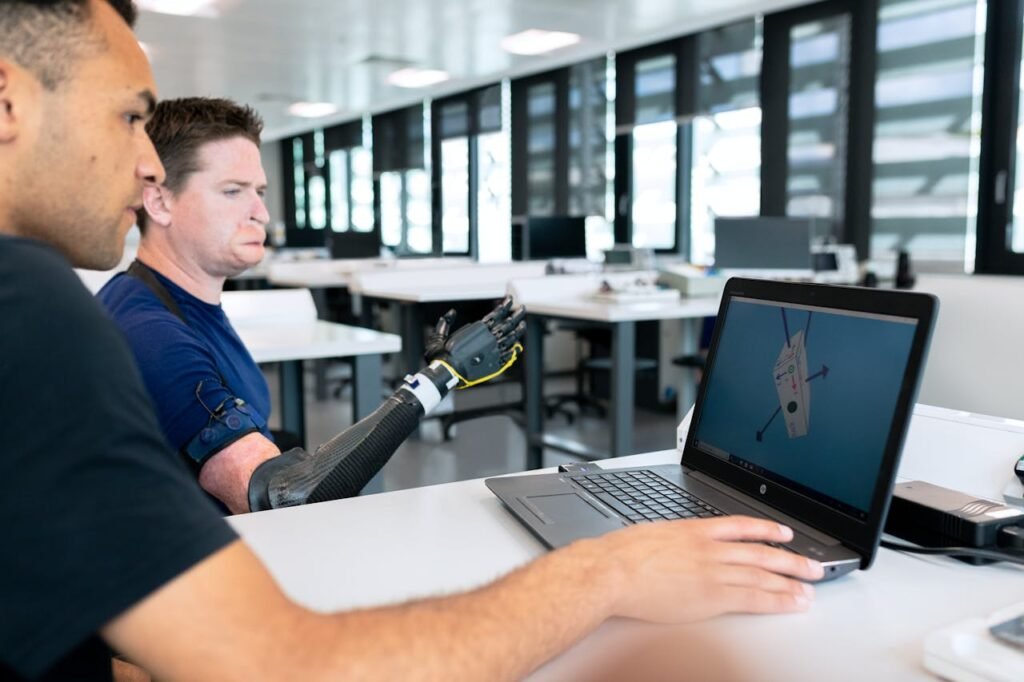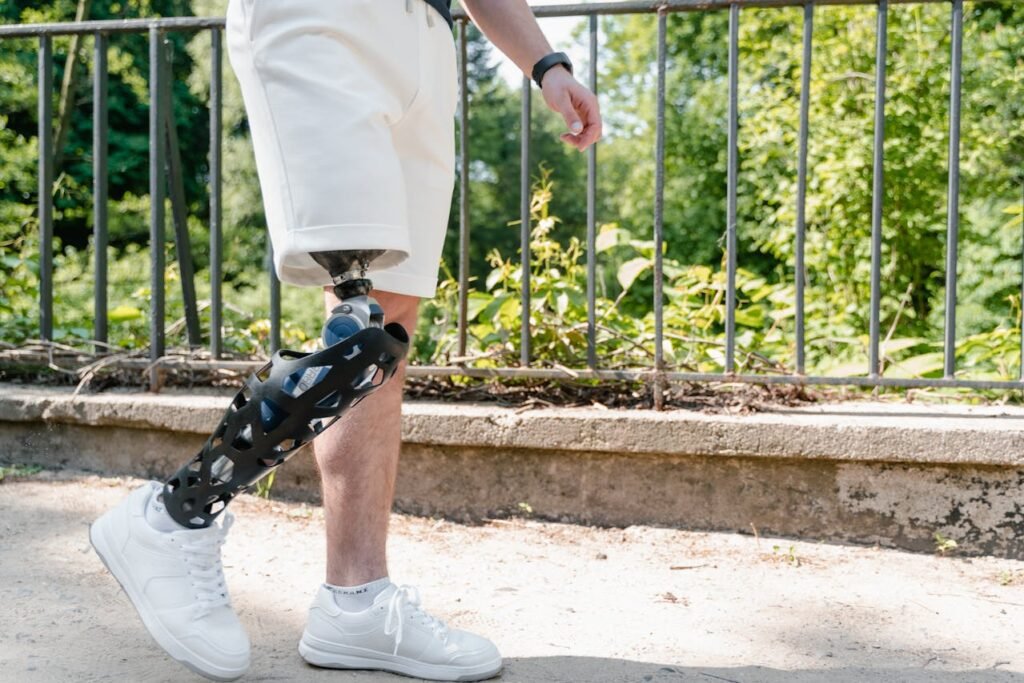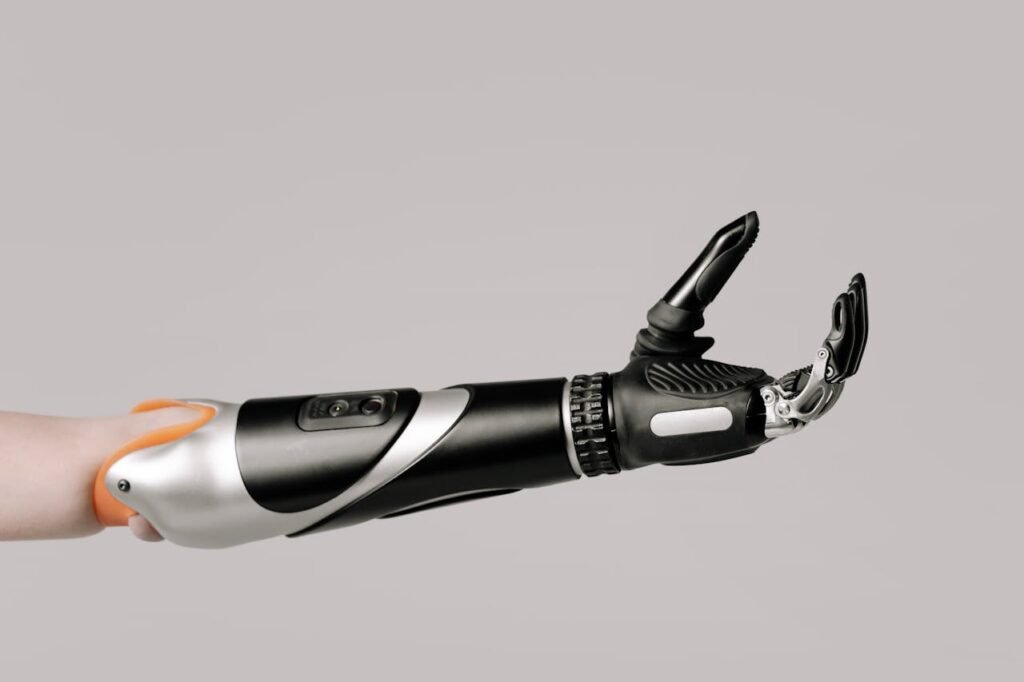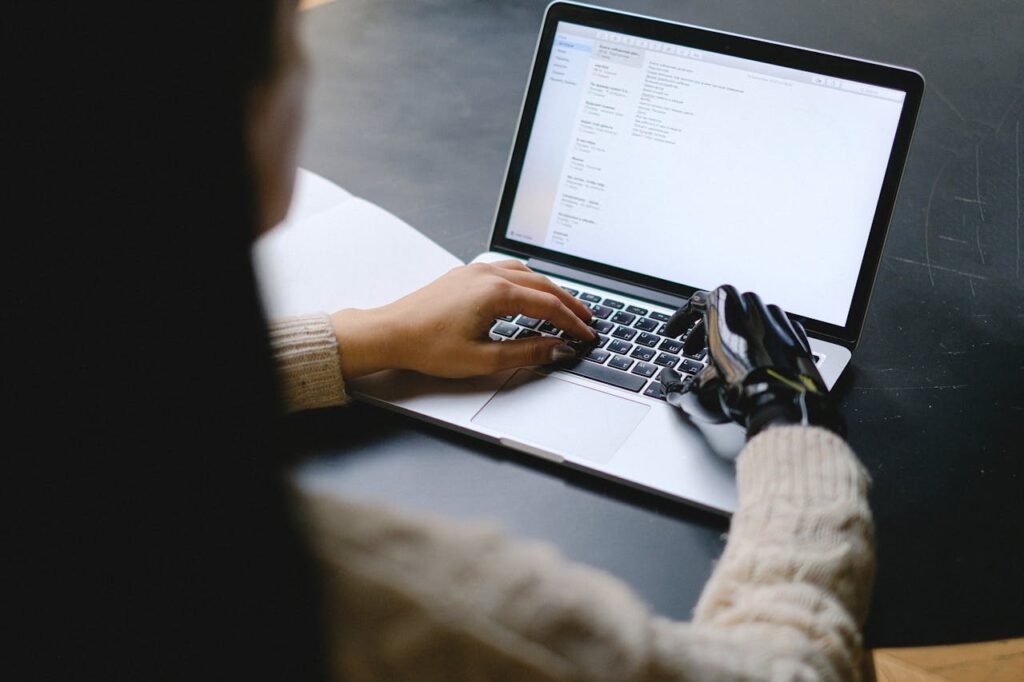The integration of artificial intelligence (AI) into modern prosthetics is revolutionizing how amputees interact with their devices, offering unprecedented levels of functionality, adaptability, and user experience. AI-driven prosthetics are no longer just tools; they are becoming intuitive extensions of the body, capable of learning, predicting, and adapting to each user’s unique needs.
This article explores how AI is transforming the prosthetics industry, the benefits it offers to users, and why it represents a pivotal moment in the journey toward more inclusive and empowering mobility solutions. Whether you’re a prosthetics user, a healthcare professional, or a business in this field, understanding the role of AI is essential for embracing the future of mobility technology.
How AI Enhances Prosthetic Functionality
At its core, AI enables prosthetics to process complex data and make intelligent decisions in real time. This capability allows prosthetics to move beyond static, mechanical functions to offer dynamic, adaptive solutions that respond to the user’s intentions and environment.
Learning User Movements
One of the most transformative aspects of AI-powered prosthetics is their ability to learn and adapt to the user’s unique movement patterns. By analyzing muscle signals, gait, or other biometric data, these devices can fine-tune their responses to ensure smoother, more natural movements.
For example, an AI-driven prosthetic leg can adapt to uneven terrain by predicting how the user’s body will shift and adjusting its motion accordingly.
This level of customization is particularly beneficial for users with active lifestyles or those engaging in varied environments. For businesses, integrating machine learning algorithms into prosthetics design allows for a product that evolves with the user, offering a truly personalized experience.

Predictive Capabilities
AI enables prosthetics to predict user intentions based on patterns in muscle activity or past behavior. For example, a myoelectric prosthetic hand can anticipate whether the user wants to perform a pinch, grip, or open-hand motion based on subtle cues.
This predictive functionality reduces the cognitive load on users, making their prosthetic feel more like a natural part of their body.
Businesses can leverage this advantage by emphasizing the intuitive nature of AI-powered prosthetics in their marketing materials. Highlighting the seamless interaction between user and device showcases the transformative potential of this technology.
Intuitive Motion Through Data Analysis
One of the most significant contributions of AI in prosthetics is its ability to analyze and interpret complex data from the user’s body. By monitoring signals from muscles, nerves, or even brain activity, AI allows prosthetics to anticipate and execute movements with remarkable accuracy.
For example, an AI-powered hand can detect subtle muscle contractions and translate them into precise actions, such as grasping an object or turning a key.
For businesses, this capability underscores the importance of investing in advanced sensor technology and machine learning algorithms. Collaborating with specialists in biomechanics or neuroscience can ensure that these systems are finely tuned to individual users, enhancing both functionality and user satisfaction.
Adaptive Responses to Changing Conditions
AI enables prosthetics to adjust dynamically to changes in the user’s environment or activity. A prosthetic leg, for example, can sense shifts in terrain—such as transitioning from a smooth surface to gravel—and adapt its joint movement to maintain balance and stability.
This adaptability reduces the effort required from the user, allowing them to navigate their surroundings more confidently and naturally.
Businesses can position this adaptability as a key differentiator in their marketing efforts. Highlighting how AI-powered prosthetics improve safety and comfort in unpredictable conditions resonates strongly with users seeking reliability and ease of use.
Enhancing Dexterity and Precision
AI excels in managing the intricate mechanics of advanced prosthetics, particularly for devices like multi-articulating hands. These hands require precise coordination of multiple joints and components to perform tasks such as typing, sewing, or gripping irregularly shaped objects.
AI’s ability to process input data and execute fine-tuned movements in real time makes these tasks achievable for users.
For businesses, demonstrating the practical benefits of enhanced dexterity can be a powerful tool for engaging prospective customers. Hosting live demonstrations or offering trial opportunities helps users experience firsthand how AI-powered prosthetics can transform their ability to perform complex tasks.
Continuous Learning and Customization
Another remarkable aspect of AI is its capacity to learn and adapt over time. Unlike traditional prosthetics, which remain static in their functionality, AI-driven devices continuously refine their performance based on the user’s habits and feedback. For instance, an AI-powered arm can learn how the user prefers to hold specific objects and optimize its grip strength accordingly.
This continuous improvement builds trust and satisfaction among users, as they experience a prosthetic that evolves alongside them. For businesses, creating user-friendly interfaces that allow for easy customization—such as apps that let users fine-tune settings—can further enhance this experience.
Providing ongoing support and updates ensures that users always have access to the latest advancements in functionality.
Benefits of AI-Driven Prosthetics
The incorporation of AI into prosthetics is about more than just enhancing functionality—it’s about redefining what’s possible for amputees. The benefits are profound, touching on everything from daily convenience to long-term health and emotional well-being.
Improved Precision and Control
AI-powered prosthetics offer a level of precision that was previously unattainable. Whether it’s gripping delicate objects without crushing them or adjusting stride length to match the user’s gait, these devices provide unparalleled control.
This precision is particularly valuable in tasks that require fine motor skills, such as writing, using utensils, or working with tools.
For businesses, focusing on real-world applications of this precision in promotional efforts helps users envision how AI-driven prosthetics can enhance their daily lives.
Reduced Physical and Mental Strain
Traditional prosthetics often require significant effort to operate, both physically and mentally. AI addresses this challenge by automating complex processes, such as balance adjustments or grip transitions.
By doing so, it reduces fatigue and allows users to focus on their activities rather than managing their device.
For businesses, emphasizing this reduction in strain can resonate with users who are seeking prosthetics that integrate seamlessly into their routines. Positioning AI as a means of restoring energy and focus builds a strong case for its adoption.

Enhanced Longevity and Maintenance
AI can also monitor the condition of the prosthetic itself, alerting users to potential issues before they become critical. Sensors embedded in the device collect data on wear and tear, battery performance, or joint alignment, enabling timely maintenance and reducing the risk of unexpected failures.
For businesses, this proactive maintenance capability is an opportunity to offer added value. Providing users with apps or platforms that connect to their prosthetic’s AI system enhances the overall experience and fosters ongoing engagement with the brand.
The Emotional and Social Impact of AI-Driven Prosthetics
AI-powered prosthetics go beyond restoring physical capabilities—they also play a significant role in enhancing emotional well-being and social confidence. By offering a more natural and intuitive experience, these devices empower users to navigate their lives with greater ease and self-assurance.
Boosting Confidence in Social Settings
For many amputees, using a prosthetic in social or professional environments can feel daunting. Concerns about awkward movements or technical limitations often lead to self-consciousness.
AI addresses this by creating prosthetics that function seamlessly and respond naturally to the user’s intent. For example, an AI-driven hand can quickly adapt its grip to shake hands or hold a glass, mimicking natural movements and reducing any sense of “otherness.”
Businesses can highlight this emotional benefit in their outreach efforts. Sharing testimonials or videos of users confidently participating in social activities helps potential customers see the life-changing impact of AI-powered prosthetics.
At Robobionics, we emphasize how our AI-driven designs enable users to reclaim their confidence in any setting.
Supporting Emotional Resilience
Adapting to a prosthetic is an emotional journey that often involves overcoming challenges and adjusting expectations. AI simplifies this process by offering a more intuitive experience, reducing frustration and helping users feel in control.
For example, a prosthetic leg that adapts to changes in terrain allows users to focus on the activity rather than the mechanics of walking.
Businesses can further support users by offering resources such as peer support groups or mentorship programs.
Creating spaces where individuals can share their experiences with AI-driven prosthetics fosters a sense of community and helps users feel supported during their adaptation process.
Examples of Innovative AI-Driven Prosthetics
The rapid evolution of AI technology has led to remarkable innovations in the prosthetics industry. These examples highlight how AI is pushing the boundaries of what prosthetics can achieve, inspiring both users and businesses to envision new possibilities.
Multi-Articulating Hands with AI Control
One of the most exciting developments is the creation of multi-articulating prosthetic hands that use AI to enable independent finger movement.
These devices can perform complex tasks like typing, playing musical instruments, or gripping irregularly shaped objects. By analyzing the user’s muscle signals in real time, AI ensures each finger moves with precision and coordination.
For businesses, promoting the versatility of these hands demonstrates how AI can expand the functionality of prosthetics. Offering demonstrations or trial sessions allows users to experience the transformative potential firsthand.

AI-Integrated Prosthetic Legs
AI-driven prosthetic legs equipped with microprocessors and sensors offer advanced capabilities such as adaptive walking, running, and stair climbing.
These devices can analyze the user’s gait and adjust joint movements to ensure balance and stability, even on challenging terrain. Some models even use predictive algorithms to anticipate the user’s next movement, creating a smoother and more natural experience.
Businesses can position these innovations as game-changers for active users, from athletes to individuals in physically demanding professions. Highlighting real-life success stories of users achieving their goals with AI-powered legs can inspire confidence and excitement.
Strategies for Businesses Embracing AI in Prosthetics
The integration of AI into prosthetics is not just an opportunity for innovation—it’s a chance to redefine the industry’s standards and user expectations. For businesses, embracing AI requires a strategic approach that prioritizes research, user collaboration, and long-term value.
Invest in Research and Development
Staying at the forefront of AI technology requires a commitment to ongoing research and development. Businesses should collaborate with experts in machine learning, biomechanics, and robotics to explore new ways of enhancing prosthetic functionality.
This might include refining algorithms for better adaptability or experimenting with new sensor technologies to improve user feedback.
At Robobionics, we actively invest in R&D to ensure our prosthetics meet the highest standards of performance and innovation. By staying ahead of emerging trends, we create devices that offer lasting value to our users.
Prioritize Accessibility
Advanced prosthetics often come with higher costs, which can limit access for some users. Businesses can address this by exploring scalable production methods, such as 3D printing, to reduce costs without compromising quality.
Offering financing options or partnering with organizations that provide subsidies can also make AI-driven prosthetics more accessible.
Additionally, businesses should focus on simplifying the user interface of AI systems to ensure that individuals of all technical abilities can benefit from the technology. Providing training and resources that demystify AI builds trust and encourages adoption.
Foster User Collaboration
AI-powered prosthetics should be designed with direct input from the people who will use them. Engaging users during the design and testing phases ensures that the final product aligns with their needs and expectations.
Regular feedback sessions, prototype testing, and co-creation initiatives create prosthetics that feel personal and intuitive.
At Robobionics, we actively involve users in every stage of development, from ideation to refinement. This collaborative approach not only enhances the user experience but also fosters strong, long-lasting relationships with our customers.

Future Trends in AI-Powered Prosthetics
The integration of AI into prosthetics is only the beginning of a technological revolution that promises to redefine mobility, functionality, and user experience. Emerging trends highlight how advancements in AI, materials, and connectivity will shape the future of prosthetics, offering exciting possibilities for users and businesses alike.
Neural Integration and Thought Control
One of the most anticipated developments in AI-powered prosthetics is the integration of neural interfaces that allow users to control their devices with their thoughts.
By connecting directly to the nervous system, these prosthetics offer a level of control and responsiveness that closely mimics natural movement.
AI plays a critical role by interpreting neural signals and translating them into precise actions, such as gripping an object or adjusting balance.
For businesses, investing in neural interface technology represents a significant opportunity to push the boundaries of innovation. Collaborating with neuroscientists and engineers to refine these systems ensures that future prosthetics meet the highest standards of functionality and user comfort.
Enhanced Sensory Feedback
AI is also enabling prosthetics to provide sensory feedback, giving users the ability to “feel” pressure, texture, or temperature through their devices.
By embedding sensors in prosthetics and using AI to process sensory data, these advancements create a more intuitive and immersive experience. For example, a user holding a fragile object can sense the amount of force applied, reducing the risk of breakage.
For businesses, sensory feedback represents a transformative feature that elevates the value of their products. Highlighting how this capability improves daily tasks and overall quality of life can create a strong emotional connection with potential customers.
AI-Driven Rehabilitation Tools
The role of AI in prosthetics extends beyond the devices themselves to include rehabilitation and training. AI-driven tools, such as virtual reality simulations or gamified exercises, are helping users adapt to their prosthetics more quickly and effectively.
These systems analyze user performance in real time, offering personalized feedback and adjustments to improve skill development.
For businesses, integrating AI into rehabilitation programs adds a layer of support that enhances the user experience. Offering access to these tools as part of the prosthetic package creates a holistic solution that addresses both physical and emotional adaptation.
Impact on Rehabilitation and Training
Rehabilitation is a critical component of the prosthetics journey, and AI is transforming how users approach this process. By combining advanced analytics with interactive technologies, AI-powered rehabilitation tools are making training more effective, engaging, and accessible.
Personalized Training Programs
AI enables the creation of personalized rehabilitation programs that adapt to each user’s progress and needs. For example, sensors in a prosthetic can track muscle activity, joint movement, or grip strength, providing detailed data that informs targeted exercises.
AI systems can then adjust the program in real time, ensuring users build the necessary skills at their own pace.
For businesses, offering personalized training as part of their services demonstrates a commitment to user success. Collaborating with physiotherapists or occupational therapists to develop these programs ensures they are both practical and effective.

Virtual and Augmented Reality in Rehabilitation
Virtual reality (VR) and augmented reality (AR) are emerging as powerful tools in prosthetic rehabilitation. These technologies immerse users in interactive environments where they can practice using their prosthetic in simulated real-world scenarios.
AI enhances this experience by analyzing user performance and providing feedback to improve technique and confidence.
Businesses that incorporate VR and AR into their rehabilitation offerings position themselves as leaders in innovation. Demonstrating these tools during consultations or trials helps potential customers see the value of a comprehensive training program.
Gamification for Motivation
Rehabilitation can be a challenging and repetitive process, but gamification adds an element of fun and motivation. AI-powered systems can turn exercises into engaging games, where users earn rewards or track their progress against goals.
For example, a user might complete virtual tasks, such as stacking objects or navigating an obstacle course, to improve their skills.
At Robobionics, we’ve integrated gamified training tools into our services, creating an enjoyable learning experience that keeps users motivated and excited about their progress.
Actionable Advice for Businesses Navigating AI in Prosthetics
The incorporation of AI into prosthetics is a significant shift that requires businesses to adapt their strategies, operations, and user engagement practices. By focusing on innovation, collaboration, and accessibility, companies can harness the potential of AI to deliver transformative solutions.
Invest in User Education
As AI-driven prosthetics introduce advanced features, educating users is more important than ever. Many individuals may feel intimidated by the technology or unsure of how to use it effectively.
Providing clear, accessible resources—such as tutorials, user manuals, or interactive workshops—empowers users to feel confident in their prosthetic.
For businesses, prioritizing education also builds trust and strengthens the relationship with customers. At Robobionics, we make user education a cornerstone of our approach, ensuring every individual understands the capabilities and care requirements of their device.
Focus on Scalability
While AI prosthetics offer incredible benefits, they can also be resource-intensive to produce. Businesses should explore scalable production methods that balance quality with efficiency.
For example, leveraging 3D printing for rapid prototyping or modular designs for simplified assembly can reduce costs and streamline manufacturing.
For companies looking to expand their reach, scalability is key to entering new markets and meeting growing demand. By investing in efficient production processes, businesses can maintain competitiveness while delivering high-quality solutions.
Collaborate Across Disciplines
The development of AI-powered prosthetics requires expertise from multiple fields, including engineering, neuroscience, software development, and healthcare.
Businesses that foster interdisciplinary collaboration can create more innovative and effective products. Partnering with research institutions, tech firms, or rehabilitation centers brings diverse perspectives and resources to the table.
At Robobionics, we actively seek collaborations with industry leaders and academic experts, ensuring our prosthetics incorporate the latest advancements in AI and design.

Conclusion
AI is revolutionizing the prosthetics industry, offering amputees unparalleled functionality, adaptability, and empowerment. From personalized movement patterns to advanced sensory feedback, AI-driven prosthetics are transforming the way users interact with their devices and the world around them.
For businesses, this is a pivotal moment to embrace innovation and redefine what prosthetics can achieve. By investing in technology, prioritizing user education, and fostering interdisciplinary collaboration, companies can lead the charge in creating prosthetics that truly change lives.




Pingback: AI Innovation Trends That Are a Boon for the Disabled - Designbeep